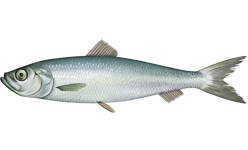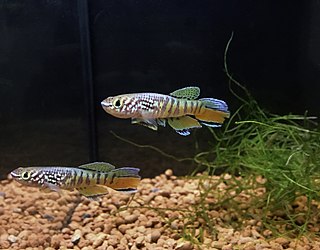
Mackerel is a common name applied to a number of different species of pelagic fish, mostly from the family Scombridae. They are found in both temperate and tropical seas, mostly living along the coast or offshore in the oceanic environment.

Herring are various species of forage fish, belonging to the order Clupeiformes.

Sardine and pilchard are common names for various species of small, oily forage fish in the herring suborder Clupeoidei. The term 'sardine' was first used in English during the early 15th century; a somewhat dubious etymology says it comes from the Italian island of Sardinia, around which sardines were once supposedly abundant.

Sprat is the common name applied to a group of forage fish belonging to the genus Sprattus in the family Clupeidae. The term also is applied to a number of other small sprat-like forage fish. Like most forage fishes, sprats are highly active, small, oily fish. They travel in large schools with other fish and swim continuously throughout the day.

Shrimpfish, also called razorfish, are five small species of marine fishes in the subfamily Centriscinae of the family Centriscidae. The species in the genera Aeoliscus and Centriscus are found in relatively shallow tropical parts of the Indo-Pacific, while the banded bellowsfish, which often is placed in the subfamily Macroramphosinae instead, is restricted to deeper southern oceans.

The Arctic cisco, also known as Arctic omul, is an anadromous species of freshwater whitefish that inhabits the Arctic parts of Siberia especially Yenisey Gulf. It can also be found in Alaska and Canada. It has a close freshwater relative in several lakes of Ireland, known as the pollan, alternatively regarded as conspecific with it, or as a distinct species.

The onefin catshark is a species of shark belonging to the family Pentanchidae, the deepwater catsharks. It is the only member of its genus, Pentanchus. It is known from two specimens collected from the Tablas Strait and Mindanao Sea off the Philippines in the Western Central Pacific. It is classified as harmless to humans and of least concern to the IUCN redlist.

The blue lyretail, also known as the Gardner's killi and formerly as the steel-blue aphyosemion, is a species of killifish. It is endemic to freshwater habitats in Nigeria and Cameroon.
Doryrhamphus janssi, commonly known as the Janss' pipefish , is a species of pipefish belonging to the family Syngnathidae.

An anchovy is a small, common forage fish of the family Engraulidae. Most species are found in marine waters, but several will enter brackish water, and some in South America are restricted to fresh water.

Fish are very diverse animals and can be categorised in many ways. Although most fish species have probably been discovered and described, about 250 new ones are still discovered every year. According to FishBase about 34,800 species of fish had been described as of February 2022, which is more than the combined total of all other vertebrate species: mammals, amphibians, reptiles and birds.

Hypleurochilus geminatus, the crested blenny, is a species of combtooth blenny found in the western Atlantic ocean. This species grows to a length of 10 centimetres (3.9 in) TL.

Clupea is genus of planktivorous bony fish belonging to the family Clupeidae, commonly known as herrings. They are found in the shallow, temperate waters of the North Pacific and the North Atlantic oceans, including the Baltic Sea. Two main species of Clupea are currently recognized: the Atlantic herring and the Pacific herring, which have each been divided into subspecies. Herrings are forage fish moving in vast schools, coming in spring to the shores of Europe and America, where they form important commercial fisheries.

Fundulopanchax is a genus of killifish living in near-coastal fresh water streams and lakes in Western Africa. All species were previously biologically classified as members of the genus Aphyosemion, with the exception of Fundulopanchax avichang, F. gresensi and F. kamdemi, which were all scientifically described after the major revision of the Aphyosemion complex.

Fundulopanchax scheeli, the emerald aphyosemion, is a species of killifish, endemic to the lower Cross River basin in Nigeria. It is a coastal rainforest fish which lives in small streams and ponds. It prefers a temperature of around 75 °F (24 °C), and a slightly acidic pH around 6–7. The specific name honours the Danish count, army colonel, explorer and ichthyologist Jørgen J. Scheel (1916–1989). F. scheeli grows to a maximum size of 6 centimetres (2.4 in) total length. It is considered to be critically endangered by the International Union for Conservation of Nature due to its very small area of occupancy and faces threats from herbicides and pesticides used in agriculture, such as in rice farming, and from deforestation.

Thunnus (Thunnus) is a paraphyletic subgenus of ray-finned bony fishes in the Thunnini, or tuna, tribe. More specifically, Thunnus (Thunnus) is a subgenus of the genus Thunnus, also known as the "true tunas". Thunnus (Thunnus) is sometimes referred to as the bluefin group and comprises five species:

Kribi killi is a species of African killifish that mainly inhabits swamps and turbid parts of brooks in the coastal rainforest. The species is endemic to Cameroon. Adult fish reach a maximum length of approximately 9 centimetres. Breeding pairs of the species most often lay their eggs over the bottom, but occasionally also among the roots of free-floating aquatic plants. Pairs stay close for some time, with just a few eggs being produced each day. It is sometimes kept in captivity but difficult to maintain and breed in an aquarium.

Fundulopanchax sjostedti, the blue gularis, golden pheasant gularis or red aphyosemion, is a species of toothcarp endemic to the Niger delta. It is only found in Nigeria and Cameroon.


















